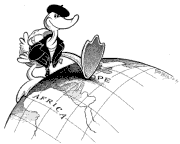03.11.08
malleability of time
A post by Scott Rosenberg took me to a NY Times article that included this nugget:
Another ingenious bit of research, conducted in Germany, demonstrated that within a brief time frame the brain can shift events forward or backward. Subjects were asked to play a video game that involved steering airplanes, but the joystick was programmed to react only after a brief delay. After playing a while, the players stopped being aware of the time lag. But when the scientists eliminated the delay, the subjects suddenly felt as though they were staring into the future. It was as though the airplanes were moving on their own before the subjects had directed them to do so.
I have heard people be spooked about dreams where it would make logical sense for something to happen, and then that event would happen in real life (waking them). For example, someone saying, “answer the phone” in the dream, followed by the real-life phone ringing. I have wondered for a long time about whether the brain shuffles the perception of time in order for the ringing phone to make more sense; the joystick experiment gives my theory some more plausibility.
When I was in college, two guys I knew messed with people’s perception of time. They took a sequence of photos something like this:
- Dave at the top of a well-known 12-story dorm with a patio on the roof.
- Dave standing next to the railing and waving at the camera.
- Dave with one leg over the railing.
- Dave standing on the roof but on the opposite side of the railing, holding on to the railing.
- Closer-in shot of Dave with his hands off the railing (and his feet not visible).
- Closer-in shot of the railing with no Dave.
- Shot taken from above of Dave sprawled on the sidewalk below.
A perfectly healthy-looking Dave would show this sequence to people, who would be completely flabbergasted. (The way Dave told the story, it seemed like a little TILT light would flash over their heads.) How could he possibly be hale after a twelve-story fall? And the photos proved that he fell! Some people quickly came to the conclusion that he must have a twin who committed suicide, and refused to budge from that conclusion.
In fact, the truth was much simpler. After shot #5, Dave climbed back over the railing and went downstairs. His buddy took shot #6 of the bare railing, and then waited for Dave to get down to the sidewalk. When Dave got downstairs, he sprawled on the sidewalk and his buddy took shot #7.
People really wanted to stitch the images together into a continuous story, but anything could happen in between the photos. All you knew was what happened at those discrete points in time when the photos were taken; everything in between was up for grabs.
This relates to how I understand wave-particle duality. (Stick with me for a second!) In the classic wave-particle duality experiment, you have two slits in a wall, a particle (e.g. photon) gun on one side of the wall, and a sensor on the other side of the wall (e.g. film). You send the particles through the slits one at a time, as slowly as you like, and you will get a diffraction pattern on the film. How is this possible? What are the particles interfering with — you’re only sending the particles through one at a time!
Well, where do you know what is happening with the particle? Where there is some sort of measurement event — at the gun and at the film. What the particle does in between is its own business. Just as you can’t see Dave going down the stairs from the photos, you can’t see what the particle does in between the gun and the film.
Furthermore, the only entropic events are at the gun and at the film. Entropy is important because it is what determines the direction of time.
My mental model of what happens in the two-slit experiment is that the particle is free to move backwards and forwards in time in between the gun and the film and so it interferes with itself. I also imagine the particle as being a three-dimensional string in four-dimensional space-time; the string is stapled at the gun and at the film, but in between it is loose to wiggle around as much as it feels like. (I have no idea how this relates to how “real” physicists think of it, but it is a mental model that makes me happy.)
Okay, now back to the phone ringing in the dream. We sense that A happened before B because our brain essentially “tags” entropic events as happening “before” and “after”. But I suspect that there is nothing that forces our brain to tell us the truth. Dave’s buddy might have taken picture #7 first, then #6, then #2-5, then #1, but when Dave presented them in the order 1-7, he caused our brain to come to a conclusion that was entirely false. Similarly, I bet our brains can do a little bit of rearranging when the phone rings.
And just like I couldn’t tell if Dave presented the photos out of order, I will never be able to tell if my brain presents impressions of the world out of order.
P.S. Props to the late Larry Rubin, who explained to me the idea of photons interfering with themselves.
P.P.S. Sorry this post was so long; I didn’t have time to make it shorter.
